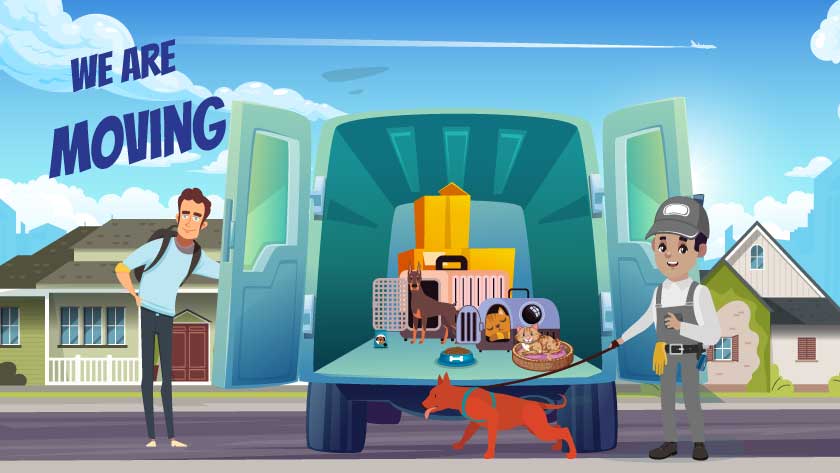A Handy Guide for Moving with Your Pets

It is indeed a challenging task to relocate your furry friend during the time of shifting. That is why you need to plan ahead and be prepared with many specific things. It is not even an exaggeration to say the process can take you a month to ensure a hassle free movement of your pet!
For your information, these points have been compiled to provide you a wholesome guide while moving with the Pets.
This guide has been divided into three sections.
First: Things to Do BEFORE the Move
#1 Consult with the Vet
Go for a check up with your Pet’s veterinarian. Ask if it is healthy enough to fly or travel long distances. Discuss the climatic condition of the new place and take suggestions.
Also, ask for the list of basic medication that may be required during travel.
#2 Make Your Pet Familiar with Crates & Containers
While traveling, your pet has to stay inside a crate or a container. Thus, it’s better to make them get used to it.
Gradually make them stay inside the crates for longer time periods; this will help them to adapt with the complexities and they won’t cause much trouble while traveling.
Tip: Never force your furry friends to go inside the crate; keep their favorite toys & treats inside, and give them time to enter and settle down in the crate by themselves.
#3 Know the Pet Rules in Your New Locality
Remember to inquire about the Pet Laws while looking out for your new home. Meet with the concerned persons and get required permissions.
#4 Make a New Collar Tag with Your Contact
A name badge is the most important tool to identify your pet. While traveling you must attach it to the neck collar of your pet. Update the information to provide the new home address, phone number, email ID, etc.
#5 Prepare a Pet Essentials Kit
Prepare a kit bag containing your pet’s food, their favorite toys and bedding, basic medicines for them while traveling, and other vital pet supplies to ensure the comfort of your pet throughout the journey.
Plan the Logistics
By Air
Your pet should have Rabies Certificates, Valid Health clearance from the Vet, and should be of at least 8 weeks of age to travel on the flight.
It should be carried in an 18” X 18” X 12” ventilated container made of soft material and should have smooth corners.
You should also know that if the container with the Pet weighs up to 5kg, it can travel with you as cabin luggage. If it is more than 5kgs, it goes as Cargo luggage with additional fees.
By Train
Your pet can freely travel with you if you have a First-Class Ticket (AC/Non-AC).
For any other coach, you have to write an application to the ‘Chief Commercial Officer’ after booking your tickets. Briefly explain the reason for carrying your pets.
Generally the application gets approved; your pet is allocated a separate berth and you get formal permission to carry them on the train.
By Car
If you are planning to travel by car then you should definitely take your pet with you. Just make sure to take care of their daily routine as you have the freedom to stop your car at any point of time.
Tip: get them used to riding for long periods of time in the car (before moving) so that they cause less trouble during tavel.
By Movers and Packers
You can transport your pets through Movers and Packers. They will ensure their safety by using all the right equipment, attend to their needs during transit, and deliver them to your doorstep in a safe manner.
Also Read- How packers and movers can help in your relocation process?
Second: Things to Do DURING the Move
#1 Keep Up Your Pet’s Usual Routine
Maintaining the daily routine of your pet is very important. Try to maintain their daily routine up to the point of movement by feeding them in time.
#2 Lease and Muzzle up!
Before finally leaving the house, lease and muzzle up your pet properly. This will make sure that they remain in your control and do not make any unnecessary sound outside.
Final: Things to Do AFTER the Move
#1 Let Them Explore the New House
Pets are easily overwhelmed by change; the strange new surroundings can add to their stress and discomfort felt during the travel.
Give them time to get used to the new house; leave some treats around the house so they venture into different rooms easily and explore the place.
#2 Find a New Vet
You should find a new veterinarian within a week of your move to the new city. Go for a normal check-up to ensure your pet hasn't developed any serious health issues or infections during the travel.
#3 Familiarize Them with the Place and People
Once you settle down in your new home, it is your duty to take the Pet for a regular spin in your locality to develop a sense of familiarity with the new surroundings and people. Once they get familiar, you need not worry anymore.
CRUX
Pets are very attached to their humans, and so are the humans with their pets!
People don’t like to leave behind their pets even with the most trusted friends and family. That is why modern traveling is well-equipped and provides a liberal provision to carry pets around. But the safety and comfort of people is always the first priority.
That is why there are some formalities and frameworks under which one should comply to avoid any trouble. It is really important to be aware of these necessary arrangements.
Wish You & Your Furry Friend a Happy, Safe Move!











